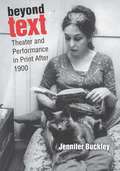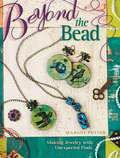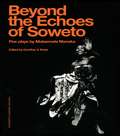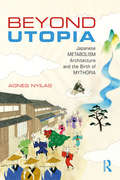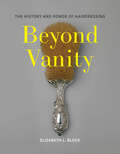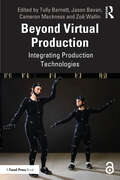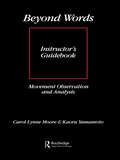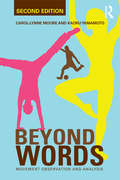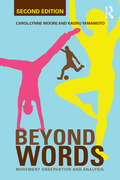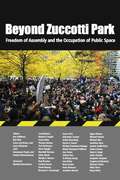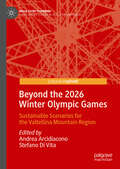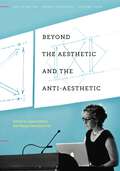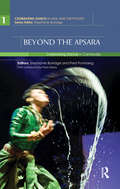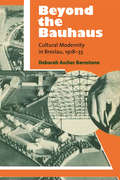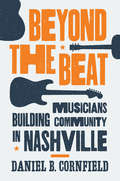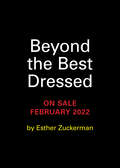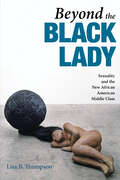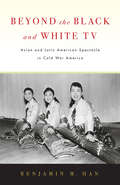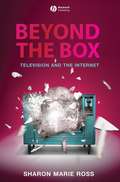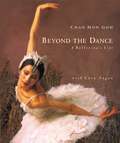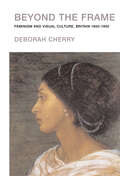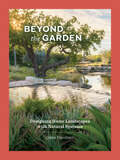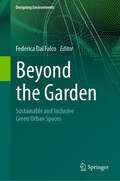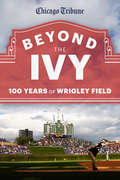- Table View
- List View
Beyond Text: Theater and Performance in Print After 1900
by Jennifer BuckleyTaking up the work of prominent theater and performance artists, Beyond Text reveals the audacity and beauty of avant-garde performance in print. With extended analyses of the works of Edward Gordon Craig, German expressionist Lothar Schreyer, the Living Theatre, Carolee Schneemann, and Guillermo Gómez-Peña, the book shows how live performance and print aesthetically revived one another during a period in which both were supposed to be in a state of terminal cultural decline. While the European and American avant-gardes did indeed dismiss the dramatic author, they also adopted print as a theatrical medium, altering the status, form, and function of text and image in ways that continue to impact both the performing arts and the book arts. Beyond Text participates in the ongoing critical effort to unsettle conventional historical and theoretical accounts of text-performance relations, which have too often been figured in binary, chronological (“from page to stage”), or hierarchical terms. Across five case studies spanning twelve decades, Beyond Text demonstrates that print—as noun and verb—has been integral to the practices of modern and contemporary theater and performance artists.
Beyond The Bead: Making Jewelry With Unexpected Finds
by Margot PotterTake Your Jewelry Beyond the BeadIf you're ready to put a new spin on your regular old beaded jewelry, this is just the book for you. Inside Beyond the Bead, you'll find more than 25 mixed-media techniques for taking your jewelry to totally unexpected places. This is truly no-holds-barred jewelry making - try your hand at molding polymer clay, hammering metal, etching glass, cyber crafting and so much more. In this book, author Margot Potter encourages you to let out all those kooky ideas rolling around inside your noggin by trying some new techniques. Then use what you've learned to make uniquely fascinating jewelry that reflects a uniquely fascinating you.
Beyond The Echoesoweto
by Geoffrey V. Davis Matsemela ManakaFirst Published in 2004. Routledge is an imprint of Taylor & Francis, an informa company.
Beyond Utopia: Japanese Metabolism Architecture and the Birth of Mythopia
by Agnes NyilasMegastructure proposals by the Japanese Metabolism group are commonly identified with the concept of utopia. Beyond this partial understanding, Agnes Nyilas suggests that rather than being merely utopian, the Megastructure of Metabolism represents a uniquely amalgam genre: the myth camouflaged as utopia. Although its Megastructure seemingly describes a desirable future condition as utopia does, it also comprises certain cultural images rooted in the collective (un)conscious of Japanese people, in accordance with the general interpretation of myth. The primary narrative of Beyond Utopia thus follows the gradual unfolding of the myth-like characteristics of its Megastructure. Myth is dealt here as an interdisciplinary subject in line with contemporary myth theories. After expounding the mechanism underlying the growing demand for a new myth in architecture (the origin of the myth), Part I discovers the formal characteristics of the Megastructure of Metabolism to give a hint of the real intention behind it. Based on this, Part II is a reexamination of their design methods, which aims to clarify the function of the myth and to suggest the meaning behind it. Finally, Part III deals with the subject matter of the myth by disclosing the meaning unfolding in the story, and suggests a new reading of Metabolism urban theory: as an attempt to reconsider the traditional Japanese space concept.
Beyond Vanity: The History and Power of Hairdressing
by Elizabeth L. BlockFrom the award-winning author of Dressing Up, a riveting and diverse history of women’s hair that reestablishes the cultural power of hairdressing in nineteenth-century America.In the nineteenth century, the complex cultural meaning of hair was not only significant, but it could also impact one’s place in society. After the Civil War, hairdressing was also a growing profession and the hair industry a mainstay of local, national, and international commerce. In Beyond Vanity, Elizabeth Block expands the nascent field of hair studies by restoring women’s hair as a cultural site of meaning in the early United States. With a special focus on the places and spaces in which the hair industry operated, Block argues that the importance of hair has been overlooked due to its ephemerality as well as its misguided association with frivolity and triviality. As Block clarifies, hairdressing was anything but frivolous.Using methods of visual and material culture studies informed by concepts of cultural geography, Block identifies multiple substantive categories of place and space within which hair acted. These include the preparatory places of the bedroom, hair salon, and enslaved peoples’ quarters, as well as the presentation places of parties, fairs, stages, and workplaces. Here are also the untold stories of business owners, many of whom were women of color, and the creators of trendsetting styles like the pompadour and Gibson Girl bouffant. Block’s ground-breaking study examines how race and racism affected who participated in the presentation and business of hair, and according to which standards. The result of looking closely at the places and spaces of hair is a reconfiguration that allows a new understanding of the cultural power of hair in the period.
Beyond Virtual Production: Integrating Production Technologies
by Barnett, Edited by Tully Jason Bevan Cameron Mackness Zoë WallinBeyond Virtual Production brings together a range of creative practice research projects that have been undertaken in The Void, an early-adopter university-based virtual production studio at Flinders University in South Australia.From a cross-disciplinary short virtual production film, to a VR simulation of the last 100 seconds of life of earth, to the live performance of the virtual band Big Sands, to augmented and extended reality, to archaeological projects, this collection captures the potential applications of virtual production technology and provides a framework for cross-disciplinary work and industry collaborations both in a university context and beyond. It offers insight into the development of virtual production courses and encompasses research into theories of performance, liveness, methods for co-creation, gender in virtual production careers, and object digitization and its representation while highlighting significant pathways of industry partnerships alongside experimental art practices.Creative technology and interdisciplinary practitioners, researchers, students, and teachers will find inspiration and practical guidance in these chapters.
Beyond Words: Instructor's Manual
by Carol-Lynne Moore Kaoru YamamotoThis guidebook is designed to facilitate the use of "Beyond Words" materials. By drawing on their own teaching experiences, the authors offer suggestions for attaining teaching/learning goals, and for overcoming difficulties in using the movement observation and analysis programme. Many of the creative adaptations described come from individuals at different institutions who tested "Beyond Words" while it was being developed. It is not intended, therefore, as a prescriptive document, but rather as a guide which provides many alternative ways of utilizing "Beyond Words", and which leaves the rest to the instructor.
Beyond Words: Movement Observation and Analysis
by Carol-Lynne Moore Kaoru YamamotoBeyond Words presents a range of illuminating approaches to examining every day social interactions, to help the reader understand human movement in new ways. Carol-Lynne Moore and Kaoru Yamamoto build on the principles that they expertly explored in the first edition of the book, maintaining a focus on the processes of movement as opposed to discussions of static body language. The authors combine textual discussion with a new set of website-hosted video instructions to ensure that readers develop an in-depth understanding of nonverbal communication, as well as the work of its most influential analyst, Rudolf Laban. This fully-revised, extensively illustrated second edition includes a new introduction by the authors. It presents a fascinating insight into this vital field of study, and will be an invaluable resource for scholars and practitioners in many activities, from performing and martial arts, athletics, to therapeutic and spiritual practices, conflict resolution, business interactions, and intercultural relations.
Beyond Words: Movement Observation and Analysis
by Carol-Lynne Moore Kaoru YamamotoBeyond Words presents a range of illuminating approaches to examining every day social interactions, to help the reader understand human movement in new ways.Carol-Lynne Moore and Kaoru Yamamoto build on the principles that they expertly explored in the first edition of the book, maintaining a focus on the processes of movement as opposed to discussions of static body language. The authors combine textual discussion with a new set of website-hosted video instructions to ensure that readers develop an in-depth understanding of nonverbal communication, as well as the work of its most influential analyst, Rudolf Laban.This fully-revised, extensively illustrated second edition includes a new introduction by the authors. It presents a fascinating insight into this vital field of study, and will be an invaluable resource for scholars and practitioners in many activities, from performing and martial arts, athletics, to therapeutic and spiritual practices, conflict resolution, business interactions, and intercultural relations.
Beyond Zuccotti Park: Freedom of Assembly and the Occupation of Public Space
by Shiffman Et AlIn the wake of the Occupy Wall Street movement, leading planers and social scientists examine public space today and freedom of assembly. The Occupy Wall Street movement has challenged the physical manifestation of the First Amendment rights to freedom of assembly. Where and how can people congregate today? Forty social scientists, planners, architects, and civil liberties experts explore the definition, use, role, and importance of public space for the exercise of our democratic rights to free expression. The book also discusses whose voice is heard and what factors limit the participation of minorities in Occupy activities. This foundational work puts issues of democracy and civic engagement back into the center of dialogue about the built environment.Beyond Zuccotti Park is a collaborative effort of Pratt Graduate Center for Planning and the Environment, City College of New York School of Architecture, New Village Press and its parent organization, Architects/Designers/Planners for Social Responsibility. The book is part of an open civic inquiry on the part of these organizations. The project was seeded by a series of free public forums, Freedom of Assembly: Public Space Today, held at the Center for Architecture in response to the forced clearance of Occupy activities from Zuccotti Park and public plazas throughout the country. The first two recorded programs took place on December 17, 2011 and February 4, 2012.
Beyond the 2026 Winter Olympic Games: Sustainable Scenarios for the Valtellina Mountain Region (Mega Event Planning)
by Stefano Di Vita Andrea ArcidiaconoThis volume offers a novel study of the Milan-Cortina's Winter Olympics 2026, with a focus on the mountainous region of Valtellina. It brings an up-to-date analysis of the complex interactions between mega-events and remote areas, both in terms of potentials for regeneration and risks for further segregation. Remote areas are traditionally characterized by socio-economic and spatial disparities. On the one hand, they benefit from attractive features, such as environmental and landscape resources, food and wine production, and energy production. On the other, they are by definition fragile environments, disrupted by the contradictions of international tourism, climate change, limited infrastructures and services, rural abandonment, and demographic decline.This book offers credible solutions for the sustainable development of mountainous regions as a legacy of Winter Olympics. It is an essential resource for scholars, professionals, and policy-makers in the fieldsof urban planning and design, architecture design, geography, sociology, and economics.
Beyond the Aesthetic and the Anti-Aesthetic (The Stone Art Theory Institutes)
by James Elkins Harper MontgomeryEach of the five volumes in the Stone Art Theory Institutes series, and the seminars on which they are based, brings together a range of scholars who are not always directly familiar with one another’s work. The outcome of each of these convergences is an extensive and “unpredictable conversation” on knotty and provocative issues about art. This fourth volume in the series, Beyond the Aesthetic and the Anti-Aesthetic, focuses on questions revolving around the concepts of the aesthetic, the anti-aesthetic, and the political. The book is about the fact that now, almost thirty years after Hal Foster defined the anti-aesthetic, there is still no viable alternative to the dichotomy between aesthetics and anti- or nonaesthetic art. The impasse is made more difficult by the proliferation of identity politics, and it is made less negotiable by the hegemony of anti-aesthetics in academic discourse on art. The central question of this book is whether artists and academicians are free of this choice in practice, in pedagogy, and in theory.The contributors are Stéphanie Benzaquen, J. M. Bernstein, Karen Busk-Jepsen, Luis Camnitzer, Diarmuid Costello, Joana Cunha Leal, Angela Dimitrakaki, Alexander Dumbadze, T. Brandon Evans, Geng Youzhuang, Boris Groys, Beáta Hock, Gordon Hughes, Michael Kelly, Grant Kester, Meredith Kooi, Cary Levine, Sunil Manghani, William Mazzarella, Justin McKeown, Andrew McNamara, Eve Meltzer, Nadja Millner-Larsen, Maria Filomena Molder, Carrie Noland, Gary Peters, Aaron Richmond, Lauren Ross, Toni Ross, Eva Schürmann, Gregory Sholette, Noah Simblist, Jon Simons, Robert Storr, Martin Sundberg, Timotheus Vermeulen, and Rebecca Zorach.
Beyond the Aesthetic and the Anti-Aesthetic: Beyond The Aesthetic And Anti-aesthetic (The Stone Art Theory Institutes #4)
by James Elkins Harper MontgomeryEach of the five volumes in the Stone Art Theory Institutes series, and the seminars on which they are based, brings together a range of scholars who are not always directly familiar with one another’s work. The outcome of each of these convergences is an extensive and “unpredictable conversation” on knotty and provocative issues about art. This fourth volume in the series, Beyond the Aesthetic and the Anti-Aesthetic, focuses on questions revolving around the concepts of the aesthetic, the anti-aesthetic, and the political. The book is about the fact that now, almost thirty years after Hal Foster defined the anti-aesthetic, there is still no viable alternative to the dichotomy between aesthetics and anti- or nonaesthetic art. The impasse is made more difficult by the proliferation of identity politics, and it is made less negotiable by the hegemony of anti-aesthetics in academic discourse on art. The central question of this book is whether artists and academicians are free of this choice in practice, in pedagogy, and in theory.The contributors are Stéphanie Benzaquen, J. M. Bernstein, Karen Busk-Jepsen, Luis Camnitzer, Diarmuid Costello, Joana Cunha Leal, Angela Dimitrakaki, Alexander Dumbadze, T. Brandon Evans, Geng Youzhuang, Boris Groys, Beáta Hock, Gordon Hughes, Michael Kelly, Grant Kester, Meredith Kooi, Cary Levine, Sunil Manghani, William Mazzarella, Justin McKeown, Andrew McNamara, Eve Meltzer, Nadja Millner-Larsen, Maria Filomena Molder, Carrie Noland, Gary Peters, Aaron Richmond, Lauren Ross, Toni Ross, Eva Schürmann, Gregory Sholette, Noah Simblist, Jon Simons, Robert Storr, Martin Sundberg, Timotheus Vermeulen, and Rebecca Zorach.
Beyond the Apsara: Celebrating Dance in Cambodia (Celebrating Dance In Asia And The Pacific Ser.)
by Stephanie BurridgeThis book celebrates and documents the resurgence of dance in Cambodia after the fall of the Khmer Rouge and the infamous Pol Pot regime. It honours the remarkable commitment of the few remaining masters of the art of dance who are reviving and preserving the famous classical dances, as well as the courage and resolution of young artists who are imaginatively pursuing their passion to forge new paths in contemporary dance. n 2003, Cambodian classical dance was awarded world heritage status by UNESCO – this confirmed the importance, and perhaps the burden, of the task of preservation. This volume includes contributions from the royal family, eminent writers and commentators and the dancers themselves. Monuments and reminders of the Killing Fields abound in the city of Phnom Penh. Nearly 2 million Cambodians, including many artists, perished during the killings or died of starvation and disease during the Khmer Rouge years. Today, the dancers, both young and old, move towards the future while respecting and honouring the past. This volume documents their journey.
Beyond the Bauhaus: Cultural Modernity in Breslau, 1918-33
by Deborah Ascher BarnstoneAlthough the Breslau arts scene was one of the most vibrant in all of Weimar-era Germany, it has largely disappeared from memory. Studies of the influence of Weimar culture on modernism have focused almost exclusively on Berlin and the Dessau Bauhaus, yet the advances that occurred in Breslau affected nearly every intellectual field, forming the basis for aesthetic modernism internationally and having an enduring impact on visual art and architecture. Breslau boasted a thriving modern arts scene and one of the premier German arts academies of the day until the Nazis began their assault on so-called degenerate art. This book charts the cultural production of Breslau-based artists, architects, art collectors, urban designers, and arts educators who operated in the margins of Weimar-era cultural debates. Rather than accepting the radical position of the German avant-garde or the reactionary position of German conservatives, many Breslauers sought a middle ground. This richly illustrated volume is the first book in English to address this history, constituting an invaluable addition to the literature on the Weimar period. Its readership includes scholars of German history, art, architecture, urban design, planning, collecting, and exhibition history; of the avant-garde, and of the development of arts academies and arts pedagogy.
Beyond the Beat
by Daniel B. CornfieldAt a time when the bulwarks of the music industry are collapsing, what does it mean to be a successful musician and artist? How might contemporary musicians sustain their artistic communities? Based on interviews with over seventy-five popular-music professionals in Nashville, Beyond the Beat looks at artist activists--those visionaries who create inclusive artist communities in today's individualistic and entrepreneurial art world. Using Nashville as a model, Daniel Cornfield develops a theory of artist activism--the ways that artist peers strengthen and build diverse artist communities.Cornfield discusses how genre-diversifying artist activists have arisen throughout the late twentieth-century musician migration to Nashville, a city that boasts the highest concentration of music jobs in the United States. Music City is now home to diverse recording artists--including Jack White, El Movimiento, the Black Keys, and Paramore. Cornfield identifies three types of artist activists: the artist-producer who produces and distributes his or her own and others' work while mentoring early-career artists, the social entrepreneur who maintains social spaces for artist networking, and arts trade union reformers who are revamping collective bargaining and union functions. Throughout, Cornfield examines enterprising musicians both known and less recognized. He links individual and collective actions taken by artist activists to their orientations toward success, audience, and risk and to their original inspirations for embarking on music careers.Beyond the Beat offers a new model of artistic success based on innovating creative institutions to benefit the society at large.
Beyond the Best Dressed: A Cultural History of the Most Glamorous, Radical, and Scandalous Oscar Fashion
by Esther ZuckermanExplore two dozen of the most glamorous, scandalous, and history-making Oscar looks in Beyond the Best Dressed, film and culture critic Esther Zuckerman's personality-filled romp through red carpet fashion, complete with original fashion drawings from illustrator Montana Forbes. From the show-stoppingly elegant (Halle Berry winning the award for Monster&’s Ball in a breathtaking Elie Saab) to the decidedly kooky (Adam Rippon in a formal harness), the Academy Awards Telecast is one of the few nights of the year devoted entirely to glamor (in all its forms). Even in the age of streaming, millions upon millions of people sit down at the same time, turn on their televisions, and watch celebrities strut down the red carpet (and, sure, win some awards). Now fans can relive the glamor, drama, and lasting legacy of some of the most influential outfits from more than ninety years of the Oscar in Beyond the Best Dressed: A Cultural History of the Most Glamorous, Radical, and Scandalous Oscar Fashion. In twenty-five essays, culture writer Esther Zuckerman explores the iconic fashion choices that made history on the most elegant stage of all, and analyzes the cultural impact of wardrobe decisions both absurd and wonderful. Beginning with Hattie McDaniel&’s historic and trendsetting turquoise gown in 1940 (worn at a table segregated from her white agent), Zuckerman goes beyond the &“best of&” lists to shine a deserved spotlight on the truly unforgettable outfits–and deciphers what those outfits represented.Beyond the Best Dressed is a first-of-its-kind commemoration of Oscar fashion that perfectly captures the glitz and the glamor for anyone who has ever been to an Oscar watch party (or texted their friends while they watched alone). Fully illustrated with whimsical fashion drawings of the outfits–including Michelle Williams' golden Versace, Sharon Stone's iconic Gap t-shirt, and Rita Moreno's groundbreaking dress worn in both 1962 and 2018–this book is a joyful and vivid odyssey that doesn&’t stop at the hem of the dress, delving deeper into the cultural effect of these fashion flash points with research and original reporting.
Beyond the Black Lady: Sexuality and the New African American Middle Class (New Black Studies Series)
by Lisa B. ThompsonIn this book, Lisa B. Thompson explores the representation of black middle-class female sexuality by African American women authors in narrative literature, drama, film, and popular culture, showing how these depictions reclaim black female agency and illustrate the difficulties black women confront in asserting sexual agency in the public sphere. Thompson broadens the discourse around black female sexuality by offering an alternate reading of the overly determined racial and sexual script that casts the middle class "black lady" as the bastion of African American propriety. Drawing on the work of black feminist theorists, she examines symptomatic autobiographies, novels, plays, and key episodes in contemporary American popular culture, including works by Anita Hill, Judith Alexa Jackson, P. J. Gibson, Julie Dash, Kasi Lemmons, Jill Nelson, Lorene Cary, and Andrea Lee.
Beyond the Black and White TV: Asian and Latin American Spectacle in Cold War America
by Benjamin M. HanThis is the first book that examines how “ethnic spectacle” in the form of Asian and Latin American bodies played a significant role in the cultural Cold War at three historic junctures: the Korean War in 1950, the Cuban Revolution in 1959, and the statehood of Hawaii in 1959. As a means to strengthen U.S. internationalism and in an effort to combat the growing influence of communism, television variety shows, such as The Xavier Cugat Show, The Ed Sullivan Show, and The Chevy Show, were envisioned as early forms of global television. Beyond the Black and White TV examines the intimate moments of cultural interactions between the white hosts and the ethnic guests to illustrate U.S. aspirations for global power through the medium of television. These depictions of racial harmony aimed to shape a new perception of the United States as an exemplary nation of democracy, equality, and globalism.
Beyond the Box: Television and the Internet
by Sharon Marie RossBeyond the Box gives students and couch potatoes alike a better understanding of what it means to watch television in an era of profound technological change. Charts the revolution in television viewing that is currently underway in living rooms across the world Probes how the Internet’s development has altered how television is made and consumed Looks at a range of topics and programmes - from voting practices on American Idol to online forums for Buffy the Vampire Slayer fans Offers a fresh and innovative perspective that focuses on the shift in audience experience and how it has blurred established boundaries
Beyond the Dance: A Ballerina's Life
by Cary Fagan Chan Hon GohShortlisted for the Rocky Mountain Book AwardNominated for The Rocky Mountain Book Award (An Alberta Children's Choice Book Award)Nominated for the 2003 Norma Fleck Award for Canadian Children's Non-FictionAn elegant, expressive dancer, Chan Hon Goh is one of the ballet world's great stars. She is a brilliant technician possessing a delicate beauty and radiant stage presence. Born in Beijing to dancer parents, she tells the story of their flight to Canada from an oppressive regime that thwarted her father's career, her rigorous training, and her battle to achieve acceptance as the only Chinese-born primaballerina in the history of the National Ballet.This fascinating look at the life of a dancer will appeal not only to the legions of Chan Hon Goh's admirers and to students of ballet, but also to young readers who understand what it is to pursue a dream.From the Hardcover edition.
Beyond the Frame: Feminism and Visual Culture, Britain 1850 -1900
by Deborah CherryBeyond the Frame rewrites the history of Victorian art to explore the relationships between feminism and visual culture in a period of heady excitement and political struggle. Artists were caught up in campaigns for women's enfranchisement, education and paid work, and many were drawn into controversies about sexuality. This richly documented and compelling study considers painting, sculpture, prints, photography, embroidery and comic drawings as well as major styles such as Pre-Raphaelitism, Neo-Classicism and Orientalism. Drawing on critical theory and post-colonial studies to analyse the links between visual media, modernity and imperialism, Deborah Cherry argues that visual culture and feminism were intimately connected to the relations of power.
Beyond the Garden: Designing Home Landscapes with Natural Systems
by Dana DavidsenThis ideal gift for gardeners features a photographic collection of beautiful, innovative, ecologically friendly gardens that will inspire and inform anyone with a green thumb, from backyard gardeners to accomplished landscape architects.Through twenty distinctive projects set across urban, suburban, and rural spaces, Beyond the Garden explores how thoughtful design and awareness of local ecology can make gardens both beautiful and sustainable. Featuring interviews with designers in the United States and the United Kingdom, this survey presents the stories and lessons behind inspirational garden projects, including stormwater conservation in the high desert of New Mexico, native woodlands restoration in coastal Maine, and land stewardship in England's Hampshire county, this comprehensive survey of eco-concious garden designs offers guiding principles to make your landscape "greener" and will spark curiosity about the natural systems just outside your front door.
Beyond the Garden: Sustainable and Inclusive Green Urban Spaces (Designing Environments)
by Federica Dal FalcoThe book addresses the interdisciplinary and multiscale theme of the design of sustainable, inclusive and creative urban green spaces in relation to the socio-ecological transition and in line with the systemic vision promoted by the 2030 Agenda, the 17 Sustainable Development Goals (SDGs) and the principles outlined by the New European Bauhaus (European Commission, 2021). The publication refers to the International Study Day organized in June 2022 by the Unit for Internationalization of the PDTA Department of the Sapienza University of Rome, develops and updates its themes, with essays that deepen theories and methodologies pursued in specific disciplinary and research fields, and with case studies of design experiments and achievements that constitute best practices at an international level in the sign of a conscious sustainability. The book is therefore part of an international and interdisciplinary dialogue and discussion focused on the challenges of climate change, economic crises and social inequalities as well as the questions that emerged during the Covid-19 pandemic. These issues are fundamental in the rethinking and reconfiguration of the role of urban green spaces, conceived as a priority place for the existence of citizens, the archetype of European culture, the conservation of biodiversity, and the relationship with nature.
Beyond the Ivy
by Chicago Tribune StaffThe first major league baseball game to take place at what is now called Wrigley Field occurred on April 23, 1914, on 4,000 yards of soil and four acres of bluegrass. Though the area may have shrunk, Chicago's love for the iconic Wrigley Field has only grown in the past century. In honor of the legendary ballpark's 100th birthday, the Chicago Tribune staff has compiled a breathtaking tribute to Wrigley Field, including historical photos, archival articles, and new content from the newspaper's award-winning journalists.Beyond the Ivy: 100 Years of Wrigley Field is a beautifully illustrated collection that captures the timeless charm of the "Friendly Confines." With contributions from beloved Chicago Tribune writers like Mike Royko, Christopher Borrelli, Paul Sullivan, Phil Vettel, and more, this book is a dazzling celebration of a national landmark and the gem of Chicago's north side. Stories of homers and blunders, heroes and villains, and triumph and tragedy are spread throughout this book, allowing readers to relive all their favorite memories right in the palm of their hands.From the time the plot of land bound by the streets Clark, Addison, Sheffield, and Waveland was the Chicago Lutheran Theological Seminary, to the construction of Weeghman Park and its renaming as Wrigley Field, this stadium has not only hosted baseball, football, and hockey, but also a century's worth of ever-changing trends in music, food, and fashion. Readers can finally join in on Wrigley's centennial celebration with this entertaining and fascinating book detailing what may very well be Chicago's greatest contribution to baseball. Beyond the Ivy, in tracing the roots of Major League Baseball's second oldest ballpark, has created a testament that-much like the cherished construction it profiles-will surely stand the test of time.
